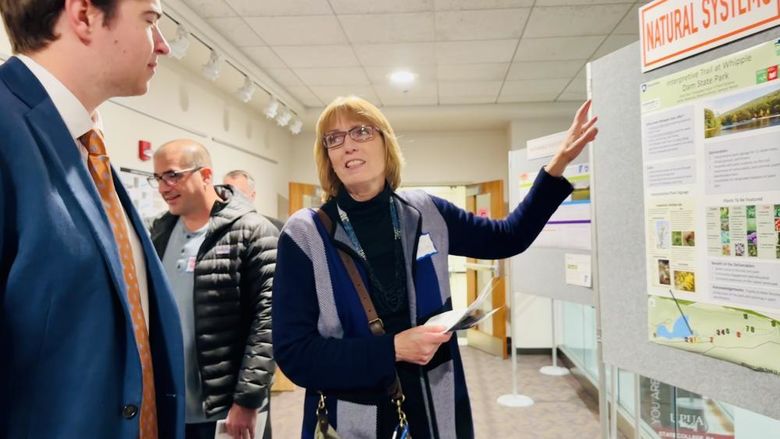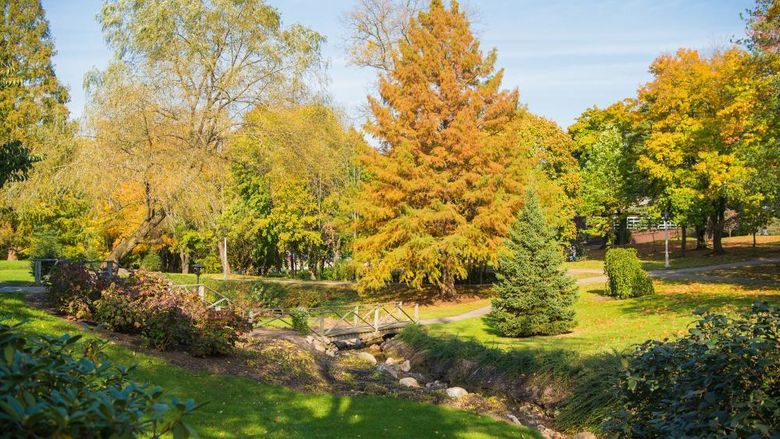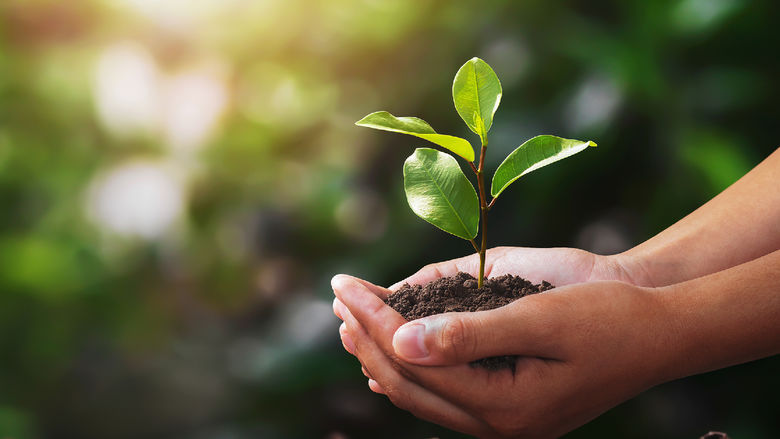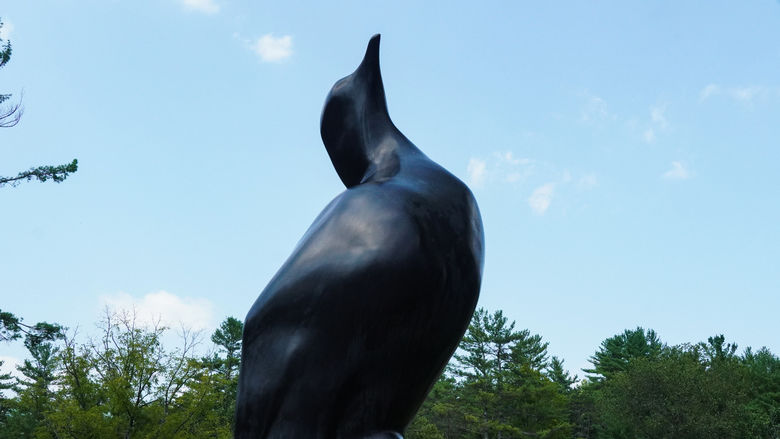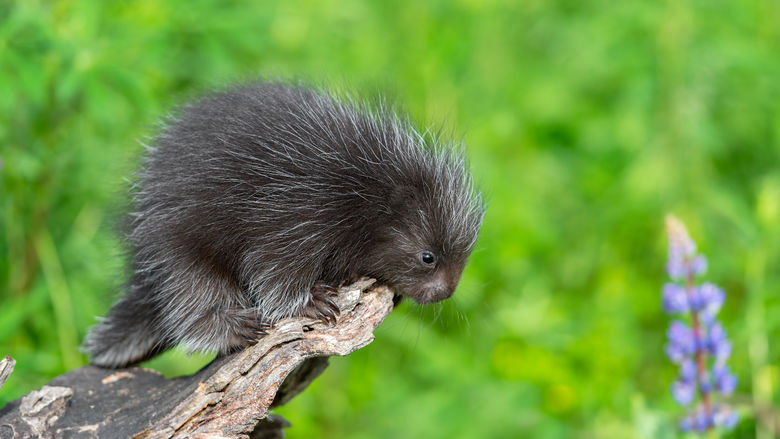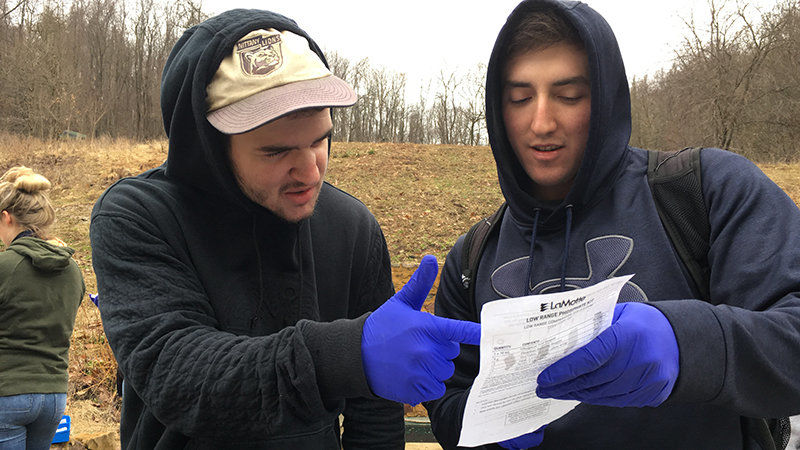
Nathan Koller and Andrew Culp prepare to collect a water sample at Last 44 farm.
Lisa Emili, associate professor in physical geography and environmental studies at Penn State Altoona, offers students in her Environmental Studies 200 course unique opportunities to "learn research by doing research." Combining history, social science, and science research aspects of environmental issues and problems, Research Methods in Environmental Studies is built on a foundation of experiential learning—and now, thanks to a partnership with a local farm, students have more hands-on opportunities than ever.
Over the last several years, Penn State Altoona has partnered with Last 44 Farm, owned by Niki and Neil Gioiosa, for the course. Opening their land for students to conduct research is a way for the couple to garner information on how the improvements they are making with organic farming are enhancing and helping sustain the landscape while giving students hands-on experience.
“We bought the property about three years ago and have been getting it back into farming shape. I thought it was a great idea to let the students get some real-world experience here, and I benefit from what results they find. It’s neat to have them out here working, and we’re happy to have them.”
— Neil Gioiosa
The history component of the course, led by Brian Black, Distinguished Professor of history and environmental studies, takes a look at the local food movement, how agricultural land should be preserved, and how that fits with Pennsylvania history.
The social science section, led by Nicholas Rowland, associate professor in sociology and environmental studies, focuses on how basic social science has been traditionally oriented more toward humans than the environment. Rowland says his primary goal for the course is to get students not just to study social science but to do it—in this case, by creating and deploying an actual survey and then analyzing the results. The survey was released to Penn State Altoona faculty and staff to assess their interest in local organic produce and natural, pasture-raised meats. Rowland and the students worked with the Gioiosas to determine what they are interested in selling and developed a survey using principles for quality question production.
“I’m excited to see what they find and share the information back with Gioiosas. Who knows, maybe at this time next year, we will be gearing up to give community supported agriculture shares from the farm to members of our campus community,” Rowland said.
Emili is guiding students in the science aspect of the course, which includes testing and assessing the current condition of the farm’s water and soil. Future generations of the class will help track the changes, which Emili hopes will show improvements.
“Through this course, and specifically for my science component, students are getting two types of skills: research and job skills,” said Emili. “In any kind of environmental career that takes place in the field, like fish and wildlife, conservation district, or natural resources, students will find themselves doing this type of work.”
“I think this class is awesome,” said Aaron Sharp, one of the students in the course. “We are learning so much. In fact, we are already doing things I want in my career like testing water and learning how make the water clean, so this a good start for me.”
Emili said the students also get experience with report writing through the course. They have to figure out a way to write scientifically and succinctly, then prepare their results for marketing and outreach so the greater community will see the value of their work.
Each professor believes that being out in the environment is a way for students to feel more relaxed and really connect with what they’re studying. “It helps them to see the value in what they’re doing to tie it to a place and a purpose,” said Emili. “The farm project allows us to accomplish something real and helpful for the community,” added Black. “It also allows students in the environmental studies program to feel part of something permanent and ongoing.”
“I enjoy this class a lot because I’m experiencing what I’m actually going to be doing in the real world,” said student Peyton Loomis. “I’m not just sitting in a classroom hearing about it. I learn much better with hands-on activities, so being able to come out here is a great opportunity.”
“This is definitely a worthwhile course,” said Nathan Koller, another student. “We are doing so many things that I don’t get to do in my other classes.”
For Rowland, the best part of the course is watching students learn how to discover and then share those discoveries with interested parties, like the farm and the campus community. “I find that one of the benefits to students is that this course creates a sense of community among them. They complete the course having accomplished so much together. They have shared experiences that are unique to this course sequence in environmental studies.”
Black, Emili, and Rowland all believe the partnership with Last 44 Farm has changed the course for the better and opened up discussion for further projects and involvement. Past and present students of ENVST 200 have expressed interest in volunteering at the farm or doing summer or semester-long internships, which would provide more learning experiences for them.
“I am proud to be a part of this—the farm, the college, and this great environmental studies program that is unique to Penn State Altoona,” Rowland said.

